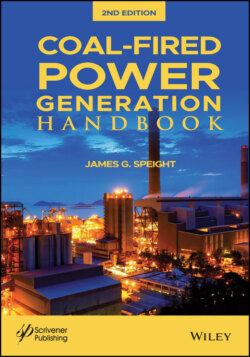Читать книгу Coal-Fired Power Generation Handbook - James Speight G., James G. Speight - Страница 18
1.4.2 Subbituminous Coal
ОглавлениеSubbituminous coal is often brown in color but more like bituminous coal than lignite. It typically contains less heating value (8,300 to 13,000 Btu per pound) and more moisture and volatile matter than bituminous coals, but lower sulfur levels (ASTM D388).
Subbituminous coal is considered a black coal, although its appearance varies from bright black to dull dark brown. Its consistency ranges from hard and strong to soft and crumbly, because it is an intermediate stage of coal between bituminous and brown coal (lignite). It is widely used for generating steam power and industrial purposes. Sometimes called black lignite, subbituminous coal is not stable when exposed to air and tends to disintegrate.
Subbituminous coal is non-coking and has less sulfur but more moisture (approximately 10 to 45% w/w) and volatile matter (up to 45% w/w) than bituminous coals. The carbon content is 35 to 45% w/w and mineral matter ranges up to 10% w/w. The sulfur content is generally under 2% w/w and the nitrogen content is on the order of 0.5 to 2% w/w. The combustion of subbituminous coal can lead to hazardous emissions that include particulate matter (PM), sulfur oxides (SOx), nitrogen oxides (NOx), and mercury (Hg).
Subbituminous coals produce combustion ash that is more alkaline than other coal ash. This characteristic can help reduce acid rain caused by coal-fired power plant emissions. Adding subbituminous coal to bituminous coal introduces alkaline by-products that are able to bind sulfur compounds released by bituminous coal and therefore reduce acid mist formation.
When subbituminous coal is burned at higher temperatures, its carbon monoxide emissions are reduced. As a result, small combustion units and poorly maintained ones are likely to increase pollution output. People who use subbituminous coal in a home furnace or firebox say that bigger lumps produce less smoke and no clinkers – however, high ash content can be a disadvantage.
Approximately 30% of available coal resources in the United States are subbituminous, a figure that surpasses other countries in its quantity of subbituminous coal resources, with estimated reserves of approximately 300,000 to 400,000 million ton (1 ton = 2,000 lbs) predominantly located in Wyoming, Illinois, Montana, and other locations west of the Mississippi river. Other countries with notable resources include Brazil, Indonesia, and Ukraine.
